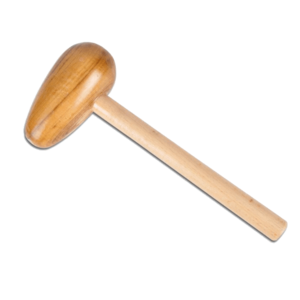Bossing Mallet: Difference between revisions
From DT Online
mNo edit summary |
|||
| (4 intermediate revisions by the same user not shown) | |||
| Line 1: | Line 1: | ||
[[File:BossingMallet.png|300px|right]] | [[File:BossingMallet.png|300px|right]] | ||
__TOC__ | __TOC__ | ||
=====Description===== | =====Description===== | ||
'''Bossing Mallets''' have 'egg-shaped' heads traditionally made from a split-resistant hardwood ''(e.g. [https://en.wikipedia.org/wiki/Buxus_sempervirens '''Boxwood'''], or [https://en.wikipedia.org/wiki/Lignum_vitae '''Lignum Vitea'''])'' but now more commonly made from [https://en.wikipedia.org/wiki/Polyethylene '''Polyethylene'''] or [https://en.wikipedia.org/wiki/Nylon '''Nylon''']. They have resilient, shock absorbing handles made from '''Cane''' or hardwood such as [https://en.wikipedia.org/wiki/Fraxinus '''Ash'''] or [https://en.wikipedia.org/wiki/Hickory '''Hickory''']. | '''Bossing Mallets''' have 'egg-shaped' heads traditionally made from a split-resistant hardwood ''(e.g. [https://en.wikipedia.org/wiki/Buxus_sempervirens '''Boxwood'''], or [https://en.wikipedia.org/wiki/Lignum_vitae '''Lignum Vitea'''])'' but now more commonly made from [https://en.wikipedia.org/wiki/Polyethylene '''Polyethylene'''] or [https://en.wikipedia.org/wiki/Nylon '''Nylon''']. They have resilient, shock absorbing handles made from '''Cane''' or hardwood such as [https://en.wikipedia.org/wiki/Fraxinus '''Ash'''] or [https://en.wikipedia.org/wiki/Hickory '''Hickory''']. | ||
=====Features and Uses===== | =====Features and Uses===== | ||
Used in conjunction with a '''[[ | Used in conjunction with a '''[[Sandbag]]''' or wooden formers when '''[[Hollowing]]''' shapes in sheet metal ''(e.g. to make a copper bowl)''. | ||
{ | {{Bossing Mallet Buyers Guide}} | ||
[[Category:Mallets]] | [[Category:Mallets]] | ||
[[Category:Beaten Metalwork]] | |||
Latest revision as of 06:33, 12 August 2017
Description
Bossing Mallets have 'egg-shaped' heads traditionally made from a split-resistant hardwood (e.g. Boxwood, or Lignum Vitea) but now more commonly made from Polyethylene or Nylon. They have resilient, shock absorbing handles made from Cane or hardwood such as Ash or Hickory.
Features and Uses
Used in conjunction with a Sandbag or wooden formers when Hollowing shapes in sheet metal (e.g. to make a copper bowl).
- Traditional Boxwood Mallets are now largely superceded by Nylon, PVC or rubber faced hammers and mallets for general work. They are available in a range of diameters and weights.
- Carpenters' Mallets with a head size of 4-5 inches (100mm - 125mm) are a suitable size for most work in Design and Technology.
- Carving Mallet heads are commonly made from Beech but Lignum Vitea heads are considered better because they are heavier. They may now be hard to find. A modern alternative is to use Polyurethane for the heads (Bronze or Brass also used). A good general size head weight for light work would be approximately 450 grams or less, and for general work, 800 grams is more suitable.
- Bossing Mallets are sized by head diameter (35, 50, 60, or 75mm). The smaller sizes are used for art metalwork and the larger sizes are for shaping and stretching sheet metal and soft roofing materials such as lead.
 |
 |
 |
 |
 |
| Nylon Hammer |
Rubber Mallet |
Carpenters Mallet |
Carvers Mallet |
Rawhide Mallet |
